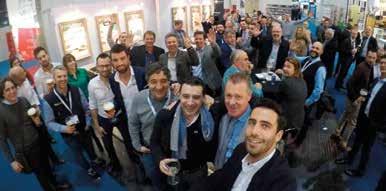Special
Drying oil/lacquer using LED
THE MARKET DICTATES DEMAND CURING WITH LED: PRODUCTION INFRASTRUCTURE DETERMINES THE DEVELOPMENT OF PRODUCTS In recent years, more and more professionals have considered drying oil or lacquer with LED. The question is how far LED curing has actually penetrated the market and what it includes. One thing which we can note is that LED curing still has its limitations and that traditional UV curing still largely prevails. However, that takes nothing away from the fact that LED curing can still have a future. We look first for an answer to the question as to how new drying with LED lamps is and in which fields is it used. We hear from the market that this sort of curing (or, rather, curing of the film, where drying more properly means that a fluid which contains solvents or water loses these components through natural or imposed vaporisation) has been developed over the last ten to fifteen years. Initially, it was used to print cosmetic packs such as bottles, boxes, tubes, and such like since this technology enables us to print and cure this spot. However, for some years now, it has been possible to cure UV inks through exposure to UV LEDs and that has been done more and more. Since one question raises the other, we also have to consider the technology behind this procedure. This means we have to consider how the curing process works and what the major difference is with UV curing.
Monochromatic source The main thing to realise is that UV LEDs (ultraviolet light-emitting diodes) form a monochromatic source with a very well defined wavelength. By contrast, mercury vapour lamps have a much broader spectrum which reaches into the infrared. And so, the advantage is that no energy is wasted and that you can work towards a precise aim. On the other hand, the very wide commercial range of UV LEDs on the market causes users some confusion. For instance, you can still say that a lot of UV LEDs still have a very low capacity without any relation to a ‘normal’ use on a wood finish. What you also see is that manufacturers concentrate on varnishes or oils which can be cured with UV LED and that these ranges could be extended considerably. It’s also interesting to note here that the production infrastructure dictates which products are developed. Manufacturers keep a close eye on these matters and upgrade their production lines when new products are developed. What this comes down to is that people are always looking for the ‘balance’ on the market between what is available and what is necessary. What a producer like the Blanchon Group does say is that the machine capacity for use on site is still not so high. In comparison with ‘classic’ UV machines, which are fitted with mercury vapour lamps, according to Blanchon they still don’t achieve the same results. They do also add that this obviously doesn’t apply to a finish in the factory, which takes place under different conditions.
Visit www.floor-forum.com
Cost price? Finally, we have perhaps the most crucial questions, and we also put them to the Blanchon Group: What is the cost price? How is LED curing doing in comparison with classic UV curing? They do say that with equal intensity (expressed in W/cm²) UV LEDs consume less energy. As we’ve already said, however, we hear that there are only a few UV LED machines with sufficient intensity to yield high-quality finishes in a conventional thickness.
Some specialists have their say Chimiver LED HARD WAX OIL - Oil based UV LED laquer LED HARD WAX OIL is a LED UV curing oil, modified with acrylate oligomers, suitable for varnishing wooden floors. The wooden floors varnished with LED HARD WAX OIL are characterized by excellent hardness, distension and elasticity. It confers the wood item a natural look, soft to the touch and oil-like staining. LED HARD WAX OIL is a laquer suitable for the application by roller coating machines. It is crosslinked by LED lamps. CERTIFICATES: RESISTANCE TO COLD LIQUIDS (EN 12720) AND RESISTANCE TO SALIVA AND SWEAT (DIN 53160) AND SAFETY OF TOYS (EN 71-3). CERTIFIED ACCORDING TO EN 13501-1.
Osmo UV and LED oils are very similar to their oxidative curing counterparts. Technically they only differ through the fact that they can forego the use of solvents and that the chemical curing is possible thanks to UV or LED radiation within a short period of time. The surface finish protects the wood surface against the penetration of moisture and dirt. Osmo UV and LED-curing oil-and-wax combinations can be adjusted on the customers’ coating units to achieve the optimal colour tone, wear resistance and gloss level. For excellent finishing results, two coats are recommended (< 20g / m2). The current market trend is a very natural, raw-look wood surface.
Tover If compared to traditional UV Mercury or Gallium lamps, LED technology has several advantages as far as the respect of the environment Is concerned: since LEDs do not emit ozone, they do not require suction systems, while their heat output is low just like their energy consumption. Besides, LED technology allows the wood boards to be packed for shipping immediately after passing under the LED lamp, thus avoiding storage on shelves for drying. Tover proposes PROTECT LED, an oil available in neutral and coloured versions, giving the wood a warm, natural and matt look. You can apply it in combination with Tover colouring systems, such as Belle Epoque or Tintoretto Design to achieve a wide range of customized effects.
Floor Forum International 124
37


















